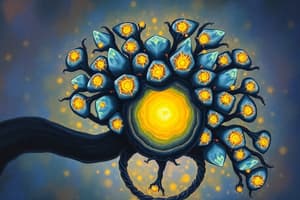Podcast
Questions and Answers
What is the primary function of mitochondria in a cell?
What is the primary function of mitochondria in a cell?
- Waste removal
- Protein synthesis
- Genetic information storage
- Energy production (correct)
Mitochondrial DNA is inherited from both parents.
Mitochondrial DNA is inherited from both parents.
False (B)
What role do pro-apoptotic proteins play in mitochondrial function?
What role do pro-apoptotic proteins play in mitochondrial function?
They promote the release of apoptotic factors, triggering programmed cell death.
The area between the outer and inner membranes of the mitochondria is called the ______.
The area between the outer and inner membranes of the mitochondria is called the ______.
Which of the following is NOT a component found in the mitochondrial matrix?
Which of the following is NOT a component found in the mitochondrial matrix?
Oxidative phosphorylation occurs in the cytoplasm.
Oxidative phosphorylation occurs in the cytoplasm.
Match the components of mitochondrial function with their respective roles:
Match the components of mitochondrial function with their respective roles:
What is created when protons are pumped into the intermembrane space?
What is created when protons are pumped into the intermembrane space?
Flashcards are hidden until you start studying
Study Notes
Structure and Function
- Double Membrane:
- Outer membrane: Smooth and permeable to small molecules.
- Inner membrane: Highly folded (cristae), contains proteins for ATP production.
- Intermembrane Space: Area between outer and inner membranes; involved in proton gradient formation.
- Matrix: Contains enzymes for the citric acid cycle, mitochondrial DNA, ribosomes, and ATP synthase.
Mitochondrial Genetics
- Mitochondrial DNA (mtDNA):
- Circular DNA, inherited maternally.
- Encodes 37 genes, including rRNA, tRNA, and some proteins for oxidative phosphorylation.
- Mutations: Can lead to mitochondrial diseases, affecting energy metabolism.
- Genetic Inheritance: Mitochondrial diseases follow a maternal inheritance pattern.
Energy Production
- Cellular Respiration: Primary function involves aerobic respiration.
- Glycolysis (cytoplasm) → Krebs Cycle (matrix) → Electron Transport Chain (inner membrane).
- ATP Generation:
- Protons are pumped into the intermembrane space, creating a gradient.
- ATP synthase utilizes this gradient to produce ATP from ADP and inorganic phosphate.
- Oxidative Phosphorylation: Key process for ATP production; involves electron transfer and chemiosmosis.
Role in Apoptosis
- Apoptosis (Programmed Cell Death): Mitochondria play a crucial role.
- Release of Cytochrome c: Triggers the apoptosome formation, activating caspases leading to cell death.
- Regulation of Apoptosis:
- Bcl-2 family proteins regulate mitochondrial membrane permeability.
- Pro-apoptotic proteins promote the release of apoptotic factors.
- Mitochondrial Dysfunction: Can lead to uncontrolled cell growth (cancer) or neurodegenerative diseases.
Structure and Function
- Double Membrane:
- Composed of an outer membrane that is smooth and allows small molecules to pass easily.
- The inner membrane is extensively folded into cristae and contains critical proteins for ATP production.
- Intermembrane Space:
- The region between the outer and inner membranes, essential for creating a proton gradient used in energy production.
- Matrix:
- Houses enzymes responsible for the citric acid cycle, mitochondrial DNA, ribosomes, and ATP synthase, which plays a vital role in energy synthesis.
Mitochondrial Genetics
- Mitochondrial DNA (mtDNA):
- Present as circular DNA and exclusively inherited from the mother.
- Contains 37 genes, which include those for ribosomal RNA (rRNA), transfer RNA (tRNA), and proteins necessary for oxidative phosphorylation.
- Mutations:
- Changes in mtDNA can cause mitochondrial diseases that critically impact energy metabolism within cells.
- Genetic Inheritance:
- Mitochondrial diseases are transmitted via a maternal inheritance mechanism, affecting offspring with maternal lineage.
Energy Production
- Cellular Respiration:
- The main function of mitochondria is facilitating aerobic respiration through a series of biochemical reactions.
- Involves three key processes: Glycolysis takes place in the cytoplasm, followed by the Krebs Cycle in the matrix, and concludes with the Electron Transport Chain located in the inner membrane.
- ATP Generation:
- Protons are pumped into the intermembrane space, establishing a proton gradient that is critical for ATP synthesis.
- ATP synthase capitalizes on this gradient to convert ADP and inorganic phosphate into ATP.
- Oxidative Phosphorylation:
- Central to ATP production, this process relies on the transfer of electrons and the mechanism of chemiosmosis to generate energy.
Role in Apoptosis
- Apoptosis (Programmed Cell Death):
- Mitochondria are pivotal in regulating the apoptosis pathway.
- Release of Cytochrome c:
- This key mitochondrial component triggers the formation of the apoptosome, activating caspases that lead to the dismantling of the cell.
- Regulation of Apoptosis:
- Bcl-2 family proteins modulate mitochondrial membrane permeability, influencing cell survival or death.
- Pro-apoptotic proteins enhance the release of factors that drive apoptosis.
- Mitochondrial Dysfunction:
- Impaired mitochondrial function can lead to unregulated cell proliferation, contributing to cancer, or to neurodegenerative conditions when cell death is improperly regulated.
Studying That Suits You
Use AI to generate personalized quizzes and flashcards to suit your learning preferences.




